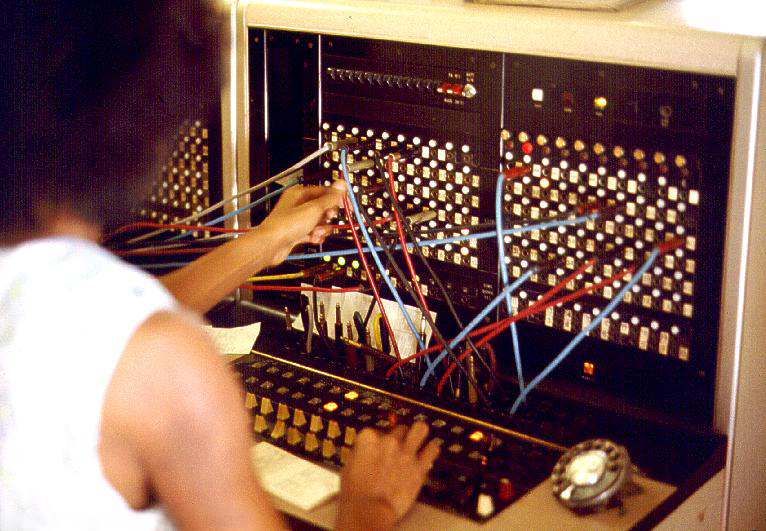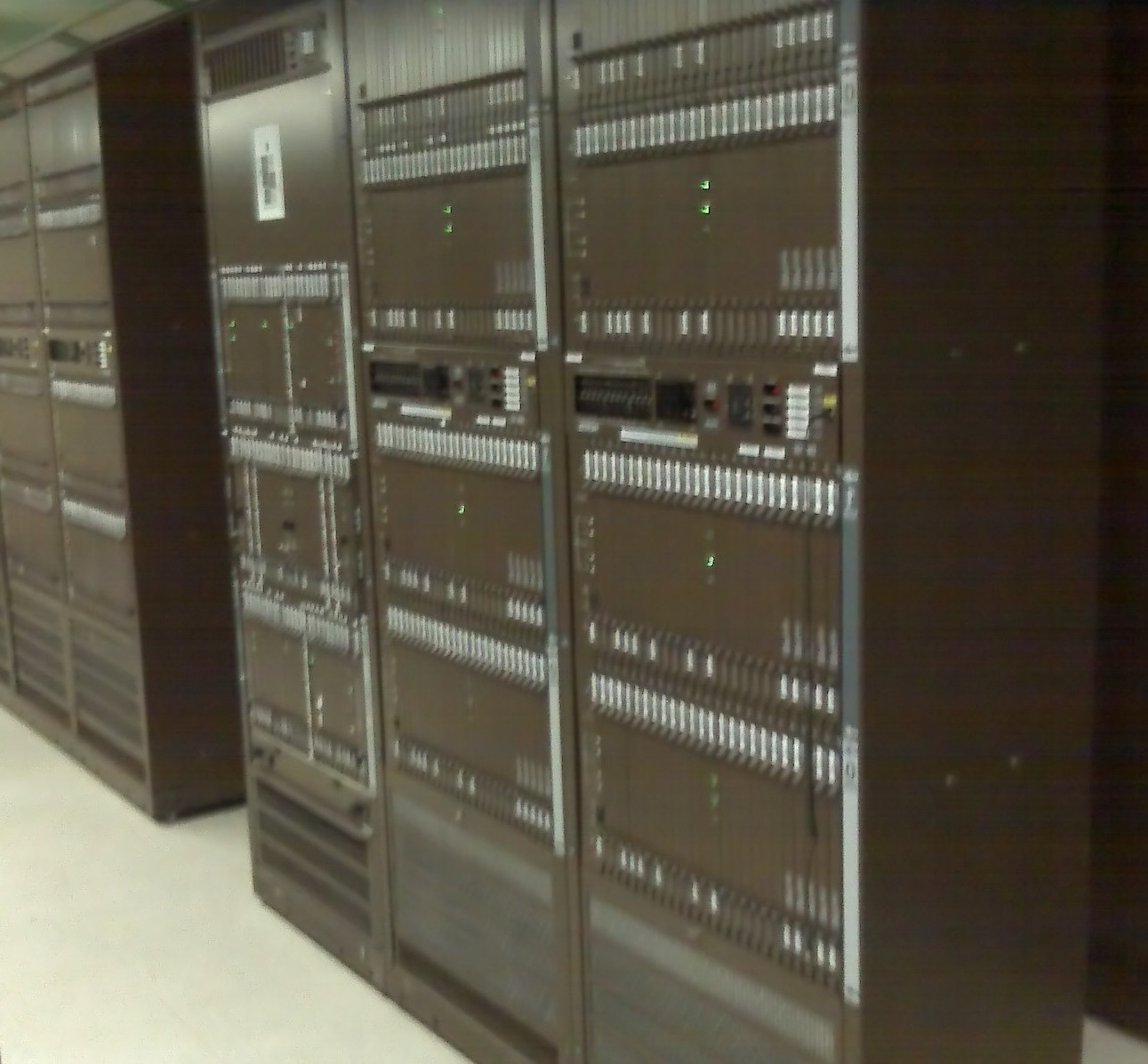|
TOPS (Nortel)
TOPS - Traffic Operator Position System is a computerized operator telephone switchboard designed by Bell-Northern Research Labs for the SP-1 4 Wire Switch in the early 1970s and still widely used today by toll and directory-assistance operators. The terminals known as 'TOPS Positions' are usually connected to Nortel DMS-100 and DMS-200 telephone switches. Systems Below are some of the different TOPS systems developed: TOPS MP TOPS Multipurpose Position. An earlier-generation operator position for toll and assistance and directory assistance. TOPS - MPX A previous-generation operator position based on industry-standard personal computer customized with Nortel Networks components and interfaces to provide connectivity with IBM directory databases. TOPS Traffic Operator Position System. Nortel Networks' operator services system is based on the DMS TOPS switch. TPC TOPS Position Controller. (Previous generation equipment required for TOPS MP positions) The processing unit prov ... [...More Info...] [...Related Items...] OR: [Wikipedia] [Google] [Baidu] |
Telephone Switchboard
A telephone switchboard was a device used to connect circuits of telephones to establish telephone calls between users or other switchboards, throughout the 20th century. The switchboard was an essential component of a manual telephone exchange, and was operated by switchboard operators who used electrical cords or switches to establish the connections. The electromechanical automatic telephone exchange, invented by Almon Strowger in 1888, gradually replaced manual switchboards in central telephone exchanges around the world. In 1919, the Bell System in Canada also adopted automatic switching as its future technology, after years of reliance on manual systems. Nevertheless, many manual branch exchanges remained operational into the second half of the 20th century in many enterprises. Later electronic devices and computer technology gave the operator access to an abundance of features. A private branch exchange (PBX) in a business usually has an attendant console, or an auto-atten ... [...More Info...] [...Related Items...] OR: [Wikipedia] [Google] [Baidu] |
Bell-Northern Research
Bell-Northern Research (BNR) was a telecommunications research and development company established In 1971 when Bell Canada and Nortel, Northern Electric combined their R&D organizations. It was jointly owned by Bell Canada and Nortel, Northern Telecom. BNR was absorbed into Nortel Networks when that company changed its name from Northern Telecom in the mid-1990s. BNR was based at the Carling Campus in Ottawa, Ontario, Canada, with campuses at locations around the world, including Research Triangle Park, North Carolina; Richardson, Texas, Richardson, Texas; Ann Arbor, Michigan, Ann Arbor, Michigan; and Harlow and Maidenhead, United Kingdom. Bell-Northern Research pioneered the development of digital electronics, digital technology, and created the first practical digital Private branch exchange, PBX, (SL1), and telephone exchange, central office (Digital Multiplex System, DMS). Under the direction of then Nortel Chief Officer, John Roth (businessman), John Roth, BNR lost its sep ... [...More Info...] [...Related Items...] OR: [Wikipedia] [Google] [Baidu] |
Nortel
Nortel Networks Corporation (Nortel), formerly Northern Telecom Limited, was a Canadian multinational telecommunications and data networking equipment manufacturer headquartered in Ottawa, Ontario, Canada. It was founded in Montreal, Quebec, in 1895 as the Northern Electric and Manufacturing Company. Until an antitrust settlement in 1949, Northern Electric was owned principally by Bell Canada and the Western Electric Company of the Bell System, producing large volumes of telecommunication equipment based on licensed Western Electric designs. At its height, Nortel accounted for more than a third of the total valuation of all companies listed on the Toronto Stock Exchange (TSX), employing 94,500 people worldwide. In 2009, Nortel filed for bankruptcy protection in Canada and the United States, triggering a 79% decline of its corporate stock price. The bankruptcy case was the largest in Canadian history and left pensioners, shareholders and former employees with enormous losses. ... [...More Info...] [...Related Items...] OR: [Wikipedia] [Google] [Baidu] |
DMS-100
The DMS-100 is a member of the Digital Multiplex System (DMS) product line of telephone exchange switches manufactured by Northern Telecom. Designed during the 1970s and released in 1979, it can control 100,000 telephone lines. The purpose of the DMS-100 Switch is to provide local service and connections to the PSTN public telephone network. It is designed to deliver services over subscribers' telephone lines and trunks. It provides plain old telephone service (POTS), mobility management for cellular phone systems, sophisticated business services such as automatic call distribution (ACD), Integrated Services Digital Network (ISDN), and Meridian Digital Centrex (MDC), formerly called Integrated Business Network (IBN). It also provides Intelligent Network functions (AIN, CS1-R, ETSI INAP). It is used in countries throughout the world. There are also DMS-200 and DMS-250 variants for tandem switches. Much of the hardware used in the DMS-100, with the possible exception of the line ... [...More Info...] [...Related Items...] OR: [Wikipedia] [Google] [Baidu] |
Telephone Switch
telephone exchange, telephone switch, or central office is a telecommunications system used in the public switched telephone network (PSTN) or in large enterprises. It interconnects telephone subscriber lines or virtual circuits of digital systems to establish telephone calls between subscribers. In historical perspective, telecommunication terms have been used with different semantics over time. The term ''telephone exchange'' is often used synonymously with ''central office'', a Bell System term. Often, a ''central office'' is defined as a building used to house the inside plant equipment of potentially several telephone exchanges, each serving a certain geographical area. Such an area has also been referred to as the exchange or exchange area. In North America, a central office location may also be identified as a ''wire center'', designating a facility to which a telephone is connected and obtains dial tone. For business and billing purposes, telecommunication carriers defin ... [...More Info...] [...Related Items...] OR: [Wikipedia] [Google] [Baidu] |
Class 5 Telephone Switches
{{No footnotes, date=August 2008 A class-5 telephone switch is a telephone exchange in the public switched telephone network (PSTN) that directly serves subscribers and manages subscriber calling features. Class-5 services include basic dial-tone, calling features, and additional digital and data services to subscribers connected to a local loop. Function A class 5 switch provides telephone service to end customers locally in the exchange area, and thus it is concerned with "subscriber type" activities: generation of dial-tone and other "comfort noises"; handling of network services such as advice of duration and charge etc. Specifically, a class-5 switch provides dial tone, local switching and access to the rest of the network. Class-4 switches do not provide subscriber lines, their role is to route calls between other switches. Typically a class-5 switch serves an area of a city, an individual town, or several villages and could serve from several hundred to 100,000 subscribe ... [...More Info...] [...Related Items...] OR: [Wikipedia] [Google] [Baidu] |
Queue
__NOTOC__ Queue () may refer to: * Queue area, or queue, a line or area where people wait for goods or services Arts, entertainment, and media *''ACM Queue'', a computer magazine * The Queue (Sorokin novel), ''The Queue'' (Sorokin novel), a 1983 novel by Russian author Vladimir Sorokin * The Queue (Abdel Aziz novel), ''The Queue'' (Abdel Aziz novel), a 2013 novel by Egyptian author Basma Abdel Aziz Mathematics and technology *Queue (abstract data type), a type of data structure in computer science **Circular queue **Double-ended queue, also known as a deque **Priority queue *FIFO (computing and electronics) *Load (computing) or queue, system load of a computer's operating system *Message queue *Queueing theory, the study of wait lines Other uses * Queue (hairstyle), a Manchurian pigtail * The Queue, a queue to view the coffin of Queen Elizabeth II during her lying in state See also *Cue (other) *FIFO (other) *First-come, first-served *Q (other) ... [...More Info...] [...Related Items...] OR: [Wikipedia] [Google] [Baidu] |
Erlang Distribution
The Erlang distribution is a two-parameter family of continuous probability distributions with support x \in independent exponential distribution">exponential variables with mean 1/\lambda each. Equivalently, it is the distribution of the time until the ''k''th event of a Poisson process with a rate of \lambda. The Erlang and Poisson distributions are complementary, in that while the Poisson distribution counts the number of events that occur in a fixed amount of time, the Erlang distribution counts the amount of time until the occurrence of a fixed number of events. When k=1, the distribution simplifies to the exponential distribution. The Erlang distribution is a special case of the gamma distribution wherein the shape of the distribution is discretised. The Erlang distribution was developed by A. K. Erlang to examine the number of telephone calls which might be made at the same time to the operators of the switching stations. This work on telephone traffic engineering has ... [...More Info...] [...Related Items...] OR: [Wikipedia] [Google] [Baidu] |
Algorithm
In mathematics and computer science, an algorithm () is a finite sequence of rigorous instructions, typically used to solve a class of specific Computational problem, problems or to perform a computation. Algorithms are used as specifications for performing calculations and data processing. More advanced algorithms can perform automated deductions (referred to as automated reasoning) and use mathematical and logical tests to divert the code execution through various routes (referred to as automated decision-making). Using human characteristics as descriptors of machines in metaphorical ways was already practiced by Alan Turing with terms such as "memory", "search" and "stimulus". In contrast, a Heuristic (computer science), heuristic is an approach to problem solving that may not be fully specified or may not guarantee correct or optimal results, especially in problem domains where there is no well-defined correct or optimal result. As an effective method, an algorithm ca ... [...More Info...] [...Related Items...] OR: [Wikipedia] [Google] [Baidu] |
TOPS Keyboard
Total Operations Processing System (TOPS) is a computer system for managing railway locomotives and rolling stock, known for many years of use in the United Kingdom. TOPS was originally developed between the Southern Pacific Railroad (SP), Stanford University and IBM as a replacement for paper-based systems for managing rail logistics. A jointly-owned consultancy company, ''TOPS On-Line Inc.'', was established in 1960 with the goal of implementing TOPS, as well as selling it to third parties. Development was protracted, requiring around 660 man-years of effort to produce a releasable build. During mid-1968, the first phase of the system was introduced on the SP, and quickly proved its advantages over the traditional methods practiced prior to its availability. In addition to SP, TOPS was widely adopted throughout North America and beyond. While it was at one point in widespread use across many of the United States railroads, the system has been perhaps most prominently used ... [...More Info...] [...Related Items...] OR: [Wikipedia] [Google] [Baidu] |
Digital Multiplex System
Digital Multiplex System (DMS) is the name shared among several different telephony product lines from Nortel Networks for wireline and wireless operators. Among them are the DMS-1 (originally named the DMS-256) Rural/Urban digital loop carrier, the DMS-10 telephone switch, the DMS SuperNode family of telephone switches (DMS-100, DMS-200, DMS-250, DMS-300, DMS-500, DMS-GSP, DMS-MSC, DMS-MTX), and the S/DMS optical transmission system. Exploratory development on the technology began at Northern Telecom's Bell Northern Research Labs in Ottawa, Ontario in 1971. The first Class 5 switch, the DMS-10, began service on 21 October 1977 in Fort White, Florida and the first toll switch (Class 4), the DMS-200, entered service in 1979 in Ottawa. The DMS-10 was the first commercially successful Class 5 digital switch in the North American market and had a profound impact on the industry. Of the numerous digital switching products introduced in the North American telephone market in the la ... [...More Info...] [...Related Items...] OR: [Wikipedia] [Google] [Baidu] |


.jpg)

.jpg)
